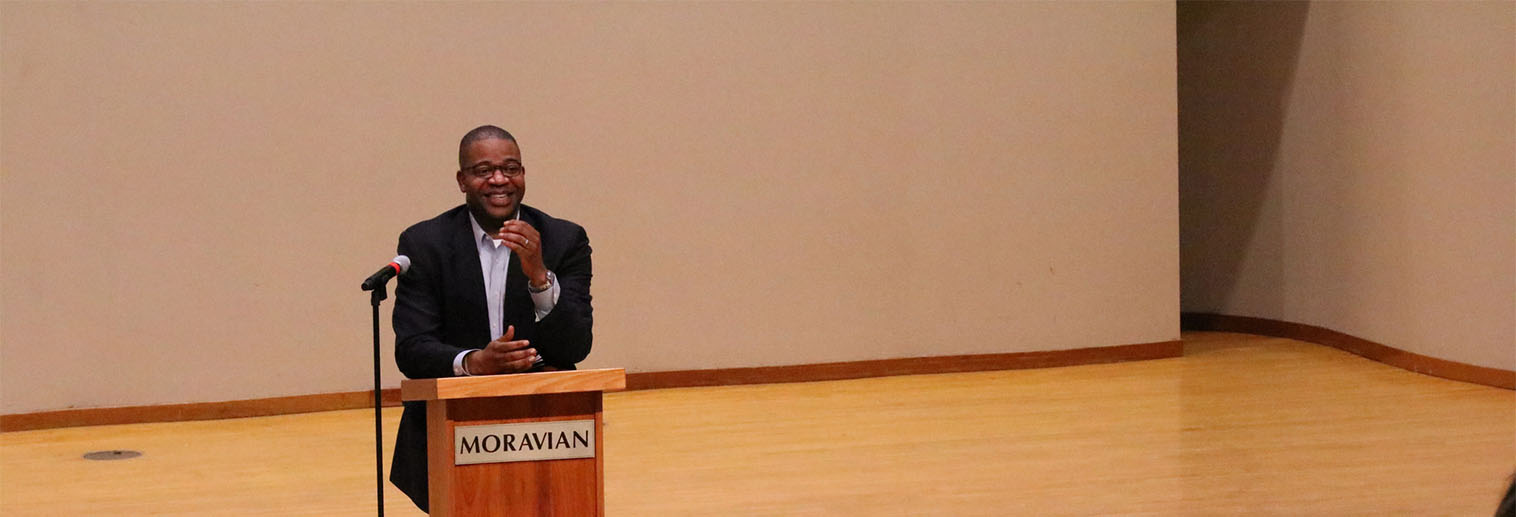The New Face of Activisim
By Keyshawn Griffith ‘19
When reflecting on James Braxton Peterson’s keynote presentation titled “Activism Then and Now,” one can honestly say that we, the audience, were asked to engage in the spirit of genuine social activism through a range of cultural and political imagery. This session, which took place in Foy Hall on Moravian University’s South Campus, was propped up by his hype man who played tracks by hip-hop/rap artist Kendrick Lamar, including Lamar’s “Hi Power,” “The Blacker the Berry,” and “Alright,” recordings that cleverly underscored the importance of Peterson, Director of Africana Studies and Associate Professor of English at Lehigh University, explained how Kendrick uses his music to be his own version of an activist. Peterson further explained that songs such as “The Blacker the Berry” can leave one to feel at odds with himself and with the broader community continuing to struggle with discrimination, indifference and the latest rounds of violence that have claimed young black men from Trayvon Martin to Tamir Rice.
To continue with his point, Peterson made references to pop rap artist Macklemore and his single “White Privilege II” and how in this song Macklemore struggles with his identity the same way that Kendrick Lamar does. Unlike Kendrick, however, Macklemore struggles with his identity because he is Caucasian and lives in a society that is easier for him to navigate while African Americans continue to struggle. Peterson counters that because Macklemore is not a member of the community, people underplay the messages he is trying to convey, which seems to double down the challenge of confronting race in its historical and contemporary context.
Peterson explains that the reason for these modern song references was that he wanted the audience to understand the extent to which the face of social activism has changed. He argues that when people think of activism, they continue to think that it has to have the same face that it had back during the Civil Rights movements, such as those presented by Dr. Martin Luther King Jr., Malcolm X, Angela Davis, and others who preached to crowds of [typically their own] people about equality. Today, Peterson counters, is marked by a more creative and diverse face and platform. Instead of a Dr. King preaching to a crowd of people, we have artists with similar ideas and beliefs who find ways to get those messages across through songs and other elements of popular culture via myriad technologies that continue to inform our age. Peterson stressed to the crowd the fact that it is fitting that the face of social activism has changed because the old face of social activism simply cannot keep pace with contemporary society. He furthers that the old activism can’t reach and resonate with the people the same way it did back during the Civil Rights Movement, and particularly as the music moves away from the often decidedly less confrontational styles of the 1950s and 1960s toward the more emphatic messages found in more modern circles given newer technologies and their expanded reach.
Finally, as Peterson closes, there are still those artists whose music resonates in such ways as to reject the more activist pose, relying on the sort of animosity as expressed through violent images and non-compromising stances that serve less to inform and inspire but rather move listeners toward the lower road. He singled out in particular Chief Keef, whose songs of drugs and gun violence move far afield from the sort of activism of the past toward a more decidedly nihilist approach; however, Peterson also made the point that for those few people who live the lives about which artists like Chief Keef rap, the music still resonates with them on a special level if only to incite those to take up a cause rather than to mindlessly seek simplistic solutions to deeply imbedded and complex problems.
In all, Peterson’s keynote served to remind his audience that social activism, while perhaps different today, continues to be an effective tool for warding off the forces of intolerance and indifference. And that’s a message that can resonate with anyone.

